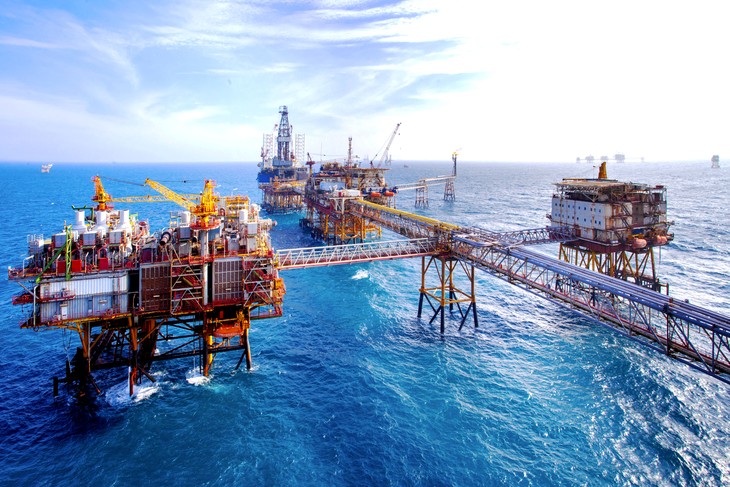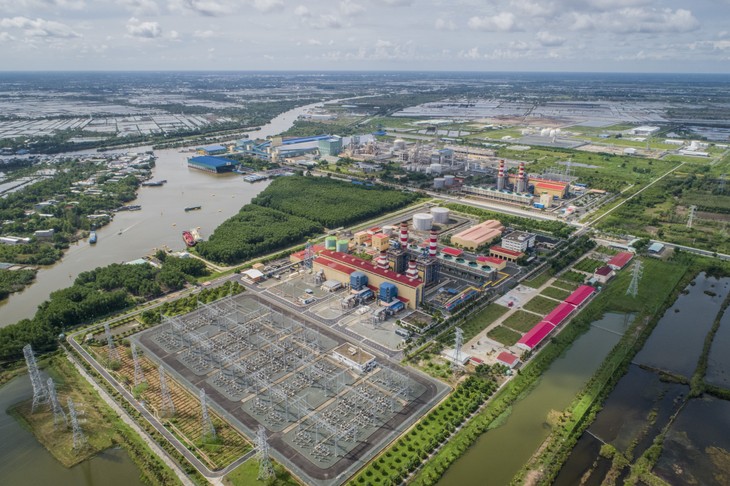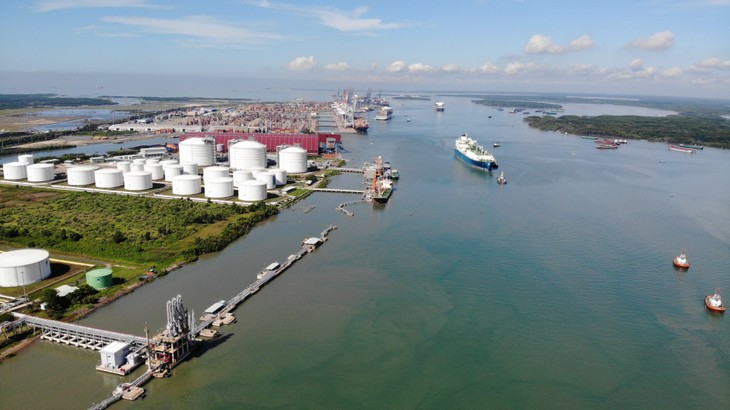 Bach Ho oil field Bach Ho oil field |
Maintaining the position of the driving force
During its development process, Petrovietnam, the core enterprise of Vietnam’s oil and gas sector, has established a comprehensive and synchronous oil and gas industry system. This system spans from oil and gas exploration and exploitation to the development of gas, electricity, and oil and gas processing and service industries. Within this framework, oil and gas exploration and exploitation represent the core areas. Additionally, Petrovietnam has successfully trained a robust and highly skilled workforce in the oil and gas sector.
Since the first tonne of crude oil was extracted in 1986, the Vietnamese oil and gas sector has exploited approximately 430 million tons of oil in Vietnam and around 180 billion cubic meters of gas. Oil and gas activities cover almost all continental shelves and the 200 nautical mile exclusive economic zone of Vietnam. Not only does the sector ensure national energy security and make significant contributions to the state budget, but it also plays a crucial role in affirming Vietnam's sovereignty, sovereign rights, and jurisdiction in the East Sea.
With its five major gas pipeline systems, Petrovietnam annually supplies nearly 9-11 billion cubic meters of gas, contributing to 35% of the national electricity production, 70% of urea production, and 70-80% of gas consumption for households nationwide. Petrovietnam is also the second-largest electricity provider, with a total capacity of 6,605 MW from its power plants, accounting for approximately 15% of the total national electricity output.
 An aerial view of the Ca Mau gas-power-fertilizer complex. An aerial view of the Ca Mau gas-power-fertilizer complex. |
Petrovietnam's two urea plants, Ca Mau and Phu My, supply over 15 million tons of urea per year to the market, meeting about 70% of the domestic fertilizer demand and helping to end the dependence on imported fertilizers. The Dung Quat Oil Refinery, an icon of Vietnam's petrochemical industry, has produced around 6 million tons of oil per year since its official operation, meeting about 30% of the domestic petroleum demand, especially fulfilling the fuel requirements of the Ministry of National Defense.
More than 30 years ago, the Vietnam-Russia joint venture Vietsovpetro had to relocate the drilling rig's base from Baku, Azerbaijan, to the coast of Ba Ria-Vung Tau province to support oil and gas exploration and exploitation activities at the Bach Ho oil field. Today, Vietnam's oil and gas industry has been able to manufacture, install, and operate drilling rigs on the continental shelf of Vietnam. Moreover, Vietnam's oil and gas machines have been exported, bringing a significant amount of hard currency to the country.
During the period from 2006 to 2015, Petrovietnam made up an average of 20-25% of the total state budget revenue, and 18-25% of the national GDP. Since 2015, Petrovietnam has continuously faced a series of challenges and difficulties caused by economic instability, falling oil prices, the Covid-19 pandemic, geopolitical conflicts, and disruptions in the global supply chain. Thanks to the resilience of “fire seekers”, Petrovietnam has stood firm and continued to achieve encouraging results. It still accounts for an average of 10-13% of the national GDP and 9-11% of the total state budget revenue. Notably, revenue from crude oil alone makes up 5-6% of the total state budget revenue.
The oil and gas industry has become a special economic sector, serving as a crucial macroeconomic regulatory tool for the government and making significant contributions to addressing the country's socio-economic issues.
Numerous projects and plants in the oil and gas sector, such as the Dung Quat Oil Refinery, the Ca Mau Gas-Power-Fertilizer Complex, Vung Ang 1 Thermal Power Plant, Thai Binh 2 Thermal Power Plant, and others, have contributed significantly to their host localities.
Quang Ngai province's budget collection jumped from 20 million USD in 2005 to 900 million USD in 2016, with over 90% of it coming from the Dung Quat Oil Refinery.
The Ca Mau Fertilizer Plant, Ca Mau Power Plants 1 and 2 with a designed capacity of 1,500 MW, the PM3-Ca Mau gas pipeline contributes 30% of Ca Mau province’s budget revenue.
Standing firmly in the new phase
In 2022, despite numerous difficulties and challenges in the post-Covid-19 pandemic period, Petrovietnam set a new record in crude oil production with 8.98 million tons; produced 1.88 million tons of urea and exported 606,000 tons, contributing 37.4% to the fertilizer export turnover; and produced petroleum meeting approximately 75% of the domestic demand.
Since the first tonne of crude oil was extracted in 1986, the Vietnamese oil and gas sector has exploited approximately 430 million tons of oil in Vietnam and around 180 billion cubic meters of gas. Oil and gas activities cover almost all continental shelves and the 200 nautical mile exclusive economic zone of Vietnam. nội dung
Despite the negative impacts of macroeconomic, geopolitical, and market factors, by October, Petrovietnam had met the targets set for the whole 2023 between 1.5 - 5 months ahead of schedule. Notably, the Group fulfilled its budget contribution plan 5 months ahead of of schedule (78.3 trillion VND by July 30, 2023) and total revenue plan 2 months and 20 days ahead of schedule (677.7 trillion VND by October 10, 2023).
Petrovietnam made two new oil discoveries in Block 16-2 (Ha Ma Vang-1X well) and Block PM3-CAA (Bunga Lavatera-1 well). For the first time in five years, the corporation has made two new discoveries in one year. Oil exploitation target of 9.29 million tons set for 2023 was met on November 21, one month and 9 days ahead of schedule.
Petrovietnam competed its petroleum production (excluding Nghi Son) plan for 2023 two months and 25 days ahead of schedule (5.53 million tons by October 6, 2023).
 The first shipment of imported LNG arrives at Thi Vai port. The first shipment of imported LNG arrives at Thi Vai port. |
In 2023, Petrovietnam achieved several significant milestones including the signing of contracts on and implementation of the Block B - O Mon Project chain, marking a significant step in the strategic gas-to-power project chain, which has been in development for nearly 20 years. This state-owned petroleum project is currently the largest in Vietnam, with an expected output of 5.06 billion cubic meters per year. The project will supply gas to four O Mon thermal power plants in Can Tho, with a total capacity of nearly 4,000 MW. Moreover, the Thi Vai liquefied natural gas (LNG) terminal with a capacity of 1 million tons per year was inaugurated at the end of October.
Earlier, the Nhon Trach 3 Power Plant completed the installation of power generators and gas turbines, laying the foundation for ensuring the commercial operation date (COD) in the fourth quarter of 2024 and the second quarter of 2025 for the Nhon Trach 4 Power Plant. Once operational, these power plants are expected to provide approximately 9 billion kWh annually to the national power grid, contributing hundreds of millions of USD to the local budget and creating jobs for thousands of people. Moreover, they play a role in promoting the transition to clean energy in Vietnam.
Numerous projects and plants in the oil and gas sector, such as the Dung Quat Oil Refinery, the Ca Mau Gas-Power-Fertilizer Complex, Vung Ang 1 Thermal Power Plant, Thai Binh 2 Thermal Power Plant, and others, have contributed significantly to their host localities.
PTSC, Petrovietnam's key service unit, became the first and only investor in Vietnam to be licensed by the Ministry of Natural Resources and Environment to carry out monitoring, survey, and assessment of marine resources for offshore wind power projects which will support the development of offshore renewable energy projects in Vietnam and export clean energy to Singapore.
Prime Minister Pham Minh Chinh emphasized that Petrovietnam has made significant contributions to socio-economic development and national defense, particularly in maintaining macroeconomic stability, controlling inflation, ensuring major balances, and promoting economic growth.
“Petrovietnam should continue to foster unity and enhance the spirit of bold thinking and action, with the aspiration to become the core unit of the oil and gas industry. The group should have strong financial and technological capabilities, high competitiveness both domestically and internationally, and play a crucial role in the construction, development, and protection of the homeland,” PM Chinh noted.
In the first 10 months of 2023, Petrovietnam’s revenue totaled 745 trillion VND, exceeding the whole year’s plan by 10%. It contributed 121 trillion VND to the state budget, surpassing the whole year’s plan by 54%.